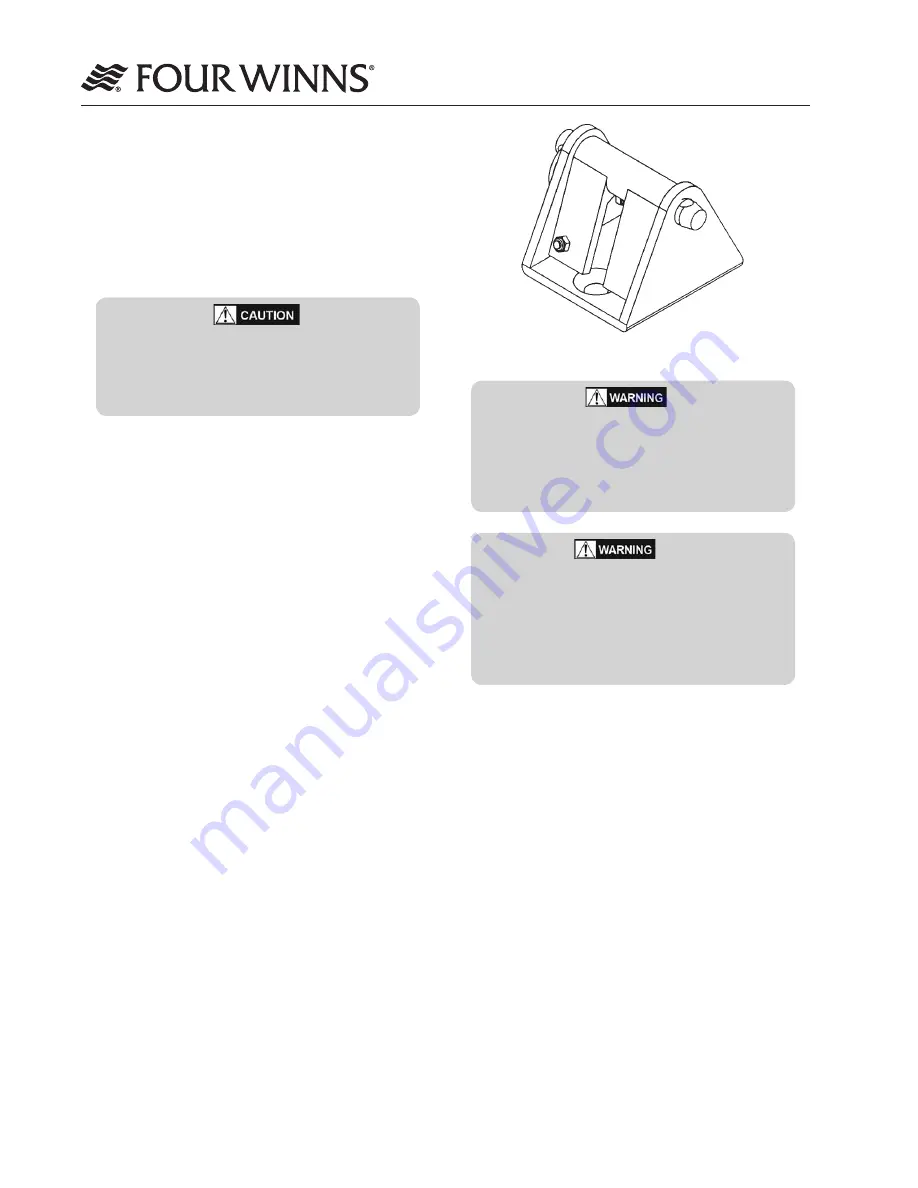
Owner’s Manual Page 38
Boating Safety - Section B
certain there is sufficient clearance for your boat to
swing in a full circle to prevent damage in case of
shifting winds.
Make certain you have enough anchor line (or scope)
for the depth of water. Your anchor line should be 6 to
7 times the depth of water anchored in. For example,
if you are in 20 feet of water, use 120 to 140 feet of
anchor line.
Secure anchor line to bow eye or deck cleat.
Never tie anchor line to a rail, rail fitting or
other hardware not designed to support this
stress.
To drop anchor:
Approach your selected anchoring site from down-
wind and come to a dead stop over the spot where
you want to drop anchor. Lower the anchor using the
windlass foot switches at the bow or the WINDLASS
switch at the helm.
Maneuver the boat slowly backwards until length of
anchor line is 6 or 7 times the depth of the water.
Fasten the anchor line around the bow eye or deck
cleat. Anchor flukes should dig in and catch. Watch
for anchor drag by check ing shoreline landmarks at
the time the anchor is dropped and one-half hour
later. If the boat has drifted away from these refer-
ence marks, the anchor is dragging and must be
reset.
To weigh anchor:
Start the engine before raising the anchor.
Slowly maneuver the boat forward to reduce tension
on the line and make retrieval of the anchor line
easier.
Raise the anchor using the windlass . Make sure
the chain stop is engaged. See Figure B16. Should
manual retrieval of the anchor ever be necessary
be sure to properly stow anchor and anchor line.
Figure B16: Chain Stop
Always be sure to raise and secure the anchor
prior to operating your boat. Failure to raise
and secure anchor before getting underway
could result in severe injury or damage to boat
from rebounding anchor.
Always utilize the chain stop provided with the
windlass/bow roller combination. The chain
stop prevents the anchor from accidently
releasing while the boat is moving thus
preventing damage to the boat or possible
injury or death to individual(s) aboard the boat.
If the anchor becomes stuck, attach the vertical line
to the mooring cleat. Wave action on the bow may lift
flukes from the bottom and free the anchor. If the
anchor is still stuck, feed out a few feet of line and
attach it to the bow cleat. Maneuver the boat around
the anchor, keeping the line firm. Determine the angle
that will work to pull the anchor free.
Anchors are available in different shapes, sizes and
weights to fit different boats, uses, and conditions.
Your Four Winns dealer can tell you which anchor
will work best for your boat.
Summary of Contents for V458
Page 1: ...V 4 5 8 O W N E R S M A N U A L 0 9 0 2 8 8 6 ...
Page 2: ......
Page 4: ...Table of Contents Owner s Manual Page 1 Table of Contents ...
Page 5: ...Owner s Manual Page 2 Table of Contents ...
Page 6: ...Table of Contents Owner s Manual Page 3 ...
Page 7: ...Owner s Manual Page 4 Table of Contents ...
Page 8: ...Table of Contents Owner s Manual Page 5 ...
Page 9: ...Owner s Manual Page 6 Table of Contents ...
Page 10: ...Table of Contents Owner s Manual Page 7 ...
Page 11: ...Owner s Manual Page 8 Table of Contents ...
Page 52: ...Owner s Manual Page 50 Warranty and Service Section D ...
Page 54: ...Owner s Manual Page 52 Warranty and Service Section D ...
Page 94: ...Owner s Manual Page 92 Fuel Systems Section I Figure I9 Fuel Valve System Components ...
Page 171: ...Owner s Manual Page 169 Pre Launch and Underway Section S Figure S3 Mooring Lines ...
Page 188: ......
Page 189: ...www fourwinns com ...
















































